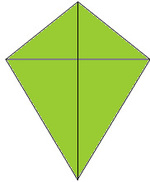

Evaluating seven squared and 17 squared gives 𝑍𝑌 squared is equal to 49 plus 289. Now, we have an equation that we can solve in order to find the length of 𝑍𝑌. In this triangle, this means that 𝑍𝑌 squared is equal to seven squared plus 17 squared. Remember the Pythagorean theorem tells us that in a right-angled triangle, the square of the hypotenuse is equal to the sum of the squares of the two shorter sides.

As the triangle is right angled, we can apply the Pythagorean theorem. And we’d like to calculate the length of the third side 𝑍𝑌. In this triangle, we know the length of two of the sides: they are seven and 17. If we focus on the lower part of the diagram, we can now see that the line 𝑍𝑌 is part of a right-angled triangle - triangle 𝑃𝑌𝑍. And hence, all four of the angles where they intersect are right angles. This means that the lines 𝑊𝑌 and 𝑋𝑍 are perpendicular. One of the key properties of a kite is that its diagonals are perpendicular. The length we’ve been asked to find is 𝑍𝑌, one of the longest sides of the kite.

We’ve been given the length of two lines in the diagram: 𝑋𝑍 and 𝑊𝑌, which are the diagonals of the kite, as each connect a pair of opposite vertices. In this question, it means that 𝑊𝑋 and 𝑊𝑍 are the same length and 𝑍𝑌 and 𝑋𝑌 are the same length. What does this mean? Well, a kite is a quadrilateral with two pairs of consecutive congruent sides. We’re told that the quadrilateral 𝑊𝑋𝑌𝑍 is a kite.


 0 kommentar(er)
0 kommentar(er)
